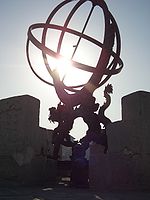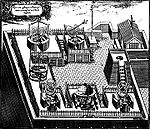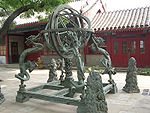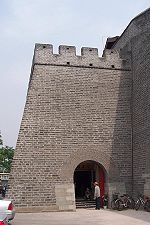
Beijing Ancient Observatory
Encyclopedia

Pretelescopic astronomy
Pretelescopic astronomy is the science of observing celestial objects with the naked eye.-History:It is believed that the first pretelesopic astronomers were the Chinese due to conclusive evidence such as the Gan Shi Xing Jing...
observatory
Observatory
An observatory is a location used for observing terrestrial or celestial events. Astronomy, climatology/meteorology, geology, oceanography and volcanology are examples of disciplines for which observatories have been constructed...
located in Beijing
Beijing
Beijing , also known as Peking , is the capital of the People's Republic of China and one of the most populous cities in the world, with a population of 19,612,368 as of 2010. The city is the country's political, cultural, and educational center, and home to the headquarters for most of China's...
, China
People's Republic of China
China , officially the People's Republic of China , is the most populous country in the world, with over 1.3 billion citizens. Located in East Asia, the country covers approximately 9.6 million square kilometres...
. The revolutionary tools used within this ancient observatory were built in 1442 during the Ming Dynasty
Ming Dynasty
The Ming Dynasty, also Empire of the Great Ming, was the ruling dynasty of China from 1368 to 1644, following the collapse of the Mongol-led Yuan Dynasty. The Ming, "one of the greatest eras of orderly government and social stability in human history", was the last dynasty in China ruled by ethnic...
, and later amended during the Qing
Qing Dynasty
The Qing Dynasty was the last dynasty of China, ruling from 1644 to 1912 with a brief, abortive restoration in 1917. It was preceded by the Ming Dynasty and followed by the Republic of China....
.
As one of the oldest observatories in the world, the Beijing Ancient Observatory grounds cover an area of 10,000 square meters. The observatory itself is located on a 15 meter tall brick platform and about 40 x 40 square meters wide, an extant portion of the old Ming Dynasty
Ming Dynasty
The Ming Dynasty, also Empire of the Great Ming, was the ruling dynasty of China from 1368 to 1644, following the collapse of the Mongol-led Yuan Dynasty. The Ming, "one of the greatest eras of orderly government and social stability in human history", was the last dynasty in China ruled by ethnic...
era city wall that once encircled Beijing. Several of the bronze
Bronze
Bronze is a metal alloy consisting primarily of copper, usually with tin as the main additive. It is hard and brittle, and it was particularly significant in antiquity, so much so that the Bronze Age was named after the metal...
astronomical
Astronomy
Astronomy is a natural science that deals with the study of celestial objects and phenomena that originate outside the atmosphere of Earth...
instruments are on the platform, and other armillary sphere
Armillary sphere
An armillary sphere is a model of objects in the sky , consisting of a spherical framework of rings, centred on Earth, that represent lines of celestial longitude and latitude and other astronomically important features such as the ecliptic...
s, sundial
Sundial
A sundial is a device that measures time by the position of the Sun. In common designs such as the horizontal sundial, the sun casts a shadow from its style onto a surface marked with lines indicating the hours of the day. The style is the time-telling edge of the gnomon, often a thin rod or a...
s, and other instruments are located nearby at ground level. It is operated as a museum in affiliation with Beijing Planetarium.
History




Hongwu Emperor
The Hongwu Emperor , known variably by his given name Zhu Yuanzhang and by his temple name Taizu of Ming , was the founder and first emperor of the Ming Dynasty of China...
, the founding Ming Emperor, transferred the instruments from Beijing to Nanjing
Nanjing
' is the capital of Jiangsu province in China and has a prominent place in Chinese history and culture, having been the capital of China on several occasions...
. When the Yongle Emperor came to power he had craftsmen make copies of the instruments in Nanjing, including the armillary sphere, the abridged armilla and the Yuan guibiao sundial, and the copies were used in the Beijing observatory.
The current observatory was completed in 1442. It served the Ming and Qing astronomers in their star-gazing reports for the Emperor. As he was considered the Son of Heaven, the movements of the heavenly bodies were an important affair. Another function was to assist sea navigation, and apparently Muslim scholars were also recruited for this expertise. In the mid 17th century, after winning an astronomy contest, the Jesuit Ferdinand Verbiest
Ferdinand Verbiest
Father Ferdinand Verbiest was a Flemish Jesuit missionary in China during the Qing dynasty. He was born in Pittem near Tielt in Flanders, later part of the modern state of Belgium. He is known as Nan Huairen in Chinese...
was awarded complete charge of the astronomy observatory by the emperor. In 1673, he supervised the rebuilding of some of the instruments. He and other Jesuits helped to further develop the observations of the stars and the planets.
During the later stages of the Qing Dynasty, members of the Eight-Nation Alliance
Eight-Nation Alliance
The Eight-Nation Alliance was an alliance of Austria-Hungary, France, Germany, Italy, Japan, Russia, the United Kingdom, and the United States whose military forces intervened in China to suppress the anti-foreign Boxers and relieve the siege of the diplomatic legations in Beijing .- Events :The...
stole some of the instruments. However, as World War I
World War I
World War I , which was predominantly called the World War or the Great War from its occurrence until 1939, and the First World War or World War I thereafter, was a major war centred in Europe that began on 28 July 1914 and lasted until 11 November 1918...
neared closure, the instruments were returned to China
China
Chinese civilization may refer to:* China for more general discussion of the country.* Chinese culture* Greater China, the transnational community of ethnic Chinese.* History of China* Sinosphere, the area historically affected by Chinese culture...
by the French
France
The French Republic , The French Republic , The French Republic , (commonly known as France , is a unitary semi-presidential republic in Western Europe with several overseas territories and islands located on other continents and in the Indian, Pacific, and Atlantic oceans. Metropolitan France...
and German
Germany
Germany , officially the Federal Republic of Germany , is a federal parliamentary republic in Europe. The country consists of 16 states while the capital and largest city is Berlin. Germany covers an area of 357,021 km2 and has a largely temperate seasonal climate...
governments. An early seismograph, of Zhang Heng
Zhang Heng
Zhang Heng was a Chinese astronomer, mathematician, inventor, geographer, cartographer, artist, poet, statesman, and literary scholar from Nanyang, Henan. He lived during the Eastern Han Dynasty of China. He was educated in the capital cities of Luoyang and Chang'an, and began his career as a...
's design used to be housed at the observatory. Some of the instruments from the Ming era are now at Purple Mountain Observatory in Nanjing
Nanjing
' is the capital of Jiangsu province in China and has a prominent place in Chinese history and culture, having been the capital of China on several occasions...
.
Instruments
- The armillary sphereArmillary sphereAn armillary sphere is a model of objects in the sky , consisting of a spherical framework of rings, centred on Earth, that represent lines of celestial longitude and latitude and other astronomically important features such as the ecliptic...
is an instrument used to measure the coordinates of the celestial bodies. This instrument is constructed of two bronzeBronzeBronze is a metal alloy consisting primarily of copper, usually with tin as the main additive. It is hard and brittle, and it was particularly significant in antiquity, so much so that the Bronze Age was named after the metal...
disks—one being known as the eclipticEclipticThe ecliptic is the plane of the earth's orbit around the sun. In more accurate terms, it is the intersection of the celestial sphere with the ecliptic plane, which is the geometric plane containing the mean orbit of the Earth around the Sun...
armillary (for tracking the sunSunThe Sun is the star at the center of the Solar System. It is almost perfectly spherical and consists of hot plasma interwoven with magnetic fields...
), and the other deemed the equatorialEquatorialEquatorial may refer to:* Equator of the Earth* Equatorial climate in meteorology* The ring-shaped outer boundary of the cross-section of a round three dimensional shape or object in geometry* The equatorial bond of a molecule in chemistry...
armillary (tracks bodies that are not the sun).
- The quadrantQuadrant (instrument)A quadrant is an instrument that is used to measure angles up to 90°. It was originally proposed by Ptolemy as a better kind of astrolabe. Several different variations of the instrument were later produced by medieval Muslim astronomers.-Types of quadrants:...
is an instrument built in 1673 and used in order to measures the altitudes and zenithZenithThe zenith is an imaginary point directly "above" a particular location, on the imaginary celestial sphere. "Above" means in the vertical direction opposite to the apparent gravitational force at that location. The opposite direction, i.e...
locations of the celestial bodies.
- The theodoliteTheodoliteA theodolite is a precision instrument for measuring angles in the horizontal and vertical planes. Theodolites are mainly used for surveying applications, and have been adapted for specialized purposes in fields like metrology and rocket launch technology...
is an instrument built in 1715 and used for measuring both altitude and azimuth coordinates of celestial bodies. The azimuth theodoliteTheodoliteA theodolite is a precision instrument for measuring angles in the horizontal and vertical planes. Theodolites are mainly used for surveying applications, and have been adapted for specialized purposes in fields like metrology and rocket launch technology...
is a relatively similar instrument lacking only the ability to record altitude.
- The astronomical sextantSextant (astronomical)Sextants for astronomical observations were used primarily for measuring the positions of stars. They are little used today, having been replaced over time by transit telescopes, astrometry techniques, and satellites such as Hipparcos....
is an instrument used for measuring the angularAngularThe angular is a large bone in the lower jaw of amphibians and reptiles , which is connected to all other lower jaw bones: the dentary , the splenial, the suprangular, and the articular...
distanceDistanceDistance is a numerical description of how far apart objects are. In physics or everyday discussion, distance may refer to a physical length, or an estimation based on other criteria . In mathematics, a distance function or metric is a generalization of the concept of physical distance...
between celestial bodies, and is also used for measuring the angular diameterDiameterIn geometry, a diameter of a circle is any straight line segment that passes through the center of the circle and whose endpoints are on the circle. The diameters are the longest chords of the circle...
of the moonMoonThe Moon is Earth's only known natural satellite,There are a number of near-Earth asteroids including 3753 Cruithne that are co-orbital with Earth: their orbits bring them close to Earth for periods of time but then alter in the long term . These are quasi-satellites and not true moons. For more...
and sunSunThe Sun is the star at the center of the Solar System. It is almost perfectly spherical and consists of hot plasma interwoven with magnetic fields...
.
- The celestial globe was built in 1673 and used to determine the timeTimeTime is a part of the measuring system used to sequence events, to compare the durations of events and the intervals between them, and to quantify rates of change such as the motions of objects....
in which the celestial bodies will rise and set; as well as the altitude and azimuth of the bodies at any given time.
See also
- Ferdinand Avguštin Hallerstein, creator of some of the instruments
- Ignaz KöglerIgnaz KöglerIgnaz Kögler was a German Jesuit missionary in China.-Life:...
, creator of some of the instruments - Ferdinand VerbiestFerdinand VerbiestFather Ferdinand Verbiest was a Flemish Jesuit missionary in China during the Qing dynasty. He was born in Pittem near Tielt in Flanders, later part of the modern state of Belgium. He is known as Nan Huairen in Chinese...
, creator of some of the instruments

